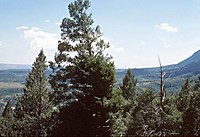Marie A. C. Langham
South Dakota State University
How do you recognize a plant that has a disease? How can you know which plant is diseased and which is healthy? These are often questions that confront people who are working with plants. What do you look for to recognize plant disease? One of the first things that plant pathologists observe when examining plants are
signs of plant pathogens and symptoms of diseases.
Signs of plant pathogens are any portion of the pathogen or its products. These can be vegetative structures such as mycelium of a fungus (Fig. 1) or the branching growth of a parasitic seed plant. They may also be reproductive structures such as the spores or spore-bearing structures (Fig. 1), the eggs of a nematode, or the seed of a parasitic seed plant. A sign may also be the product of a pathogen such as a bacterial ooze (Fig. 2) or odor which indicates a pathogen’s presence.

|  |
| Figure 1 |
Figure 2 |
Symptoms are the response of the host plant to a pathogen. It is the effect of the pathogen on the plant. Symptoms may result from overproduction, underproduction or necrosis. Overproduction symptoms are due to the stimulation of a plant cell, part, or product to increase in size or number. They can be overgrowths like tumors or galls (Fig. 3), proliferation of a certain plant part, or the overproduction of an organelle or product at a cellular level, such as accumulations of starch in leaves with local lesions. Underproduction symptoms are due to the lack or limitation of a plant part or product. Chlorosis, stunting, and rosetting (the production of highly shortened internodes resulting in a close bunchy growth) are all examples of underproduction symptoms (Fig. 4). Death of any plant part, tissue or cell is an example of a necrotic symptom (Fig. 5). Tissue death can be generalized as in blights or localized as in leaf spots. It is often marked by browning of the dying tissues.

|  |
 |
| Figure 3 |
Figure 4 |
Figure 5 |
Signs and symptoms can indicate not only that a disease is present, but also the type of pathogen that is present. For example, many plant viruses cause plants to produce a mosaic symptom. Thus, when you see a mosaic, you know that it not only indicates a disease, but also that it may be caused by a virus. This provides the pathologist with a place to start on the identification of the disease. So, the next time that you are out for a walk in the yard or park look to see how many signs and symptoms that you can observe. They may point the way for you to find a plant disease.
 |
Views: Witches’ brooms are not only found at Halloween, but they are also a symptom of some diseases. The witches’ broom (the thick cluster of branches) on this Douglas fir is caused by a dwarf mistletoe, a parasitic flowering plant. Photograph used by permission of D. L. Nickrent. Click image for an enlarged view and more information.
|
